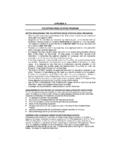Transcription of Recent Patents on Endocrine, Metabolic & Immune Drug ...
1 Send Orders for Reprints to Recent Patents on endocrine , Metabolic & Immune drug discovery 2015, 9, 000-000 1. abatacept and Glomerular Diseases: The Open Road for the Second Signal as a New Target is Settled Down Hern n Trimarchi*. Nephrology and Kidney Transplant Units, Hospital Brit nico de Buenos Aires, Buenos Aires, Argentina Received: December 8, 2014; Accepted: January 27, 2015; Revised: February 19, 2015. Abstract: Glomerulopathy is the third most important cause of kidney disease. Proteinuria is the hallmark of glomerular damage, and a marker of progression of kidney disease, cardiovascular mor- bidity and mortality. Strategies to reduce proteinuria are partially successful, and despite proteinuria management, renal disease may still progress. Immunosuppression to treat glomerulopathies is non- specific, partially effective and presents side-effects. It is critical to find safe drugs with specific podo- cyte molecular targets. Podocytes contain a complex array of proteins.
2 Lymphocyte activation antigen Hern n Trimarchi B7-1 (CD80) is located on antigen presenting cells modulating CD4+ and CD8+ T cells by interacting with co-stimulator CD28, a glycoprotein located on T-cells, or with cytotoxic T-lymphocyte protein 4 (CTLA-4) co-inhibitor. Normally, podocytes do not express B7-1. However, certain glomerulopathies are associated with an increase on the surface of podocytes of B7-1, which reduces the ability of podocytes to attach to the surrounding glomerular basement membrane, favouring podocyturia and proteinuria. When the B7-1-CTLA-4 interaction takes place, the Immune response is abro- gated, while a B7-1-CD28 coupling leads to T cell activation. abatacept binds to B7-1 by blocking the CD28 or potentiat- ing the CTLA-4 signals. In B7-1 positive podocytes, abatacept may be a specific tool to decrease proteinuria. Selected Patents are also briefly presented in this review. Keywords: abatacept , B7-1, CD28, CD80, CTLA-4, glomerulopathy, podocyte, proteinuria.
3 INTRODUCTION involved [11]. Tissue injury in glomerular diseases is medi- ated by both the innate and adaptive Immune response [9]. In Glomerulopathy is the third most important etiologic this regard, the main components of the innate limb of the entity that causes end-stage kidney disease. In addition, dia- Immune system that play a main role in glomerulonephritis betic nephropathy and hypertension, the two most frequent are neutrophils, macrophages, dendritic cells, toll-like recep- etiologies that lead to chronic renal replacement therapy, are tors and the complement system. The adaptive components also main causes of secondary glomerulopathy [1]. In any of the Immune system are composed by B cells and the pro- case, the glomerulus is always affected. Different degrees of duction of antibodies, and T cells and the production of cy- proteinuria accompany the diverse causes of glomeru- tokines and lymphokines [9]. Different mechanisms that lonephritis, and the higher its amount, the higher the risk of share many of the above mentioned components of the im- progression to kidney failure [2-5].
4 Proteinuria may be due mune system participate in each glomerulopathy, to which to many causes, but independently of the etiology, the Metabolic and hemodynamic alterations may add on, and glomerular filtration barrier, composed by the podocyte, the aggravate the structure of the glomerular filtration barrier [9- glomerular basement membrane and the endothelial cell, is 11]. Consequently, as glomerulopathies progress, proteinuria indefectibly affected [6-8]. This could be the result of local tends to increase and the glomerular filtration rate to de- or systemic insults, mainly due to immunological, Metabolic , crease [12]. With respect to the different types of glomerular or hemodynamic factors [9, 10]. In primary and many sec- diseases, some pathophysiological considerations will be ondary causes of glomerulopathies, either primary or secon- concisely made. dary, the Immune system is always involved. In minimal change disease, the complement system is not In the case of secondary causes of glomerular diseases involved and no autoimmune features are present [9].
5 How- due to Metabolic or hemodynamic derangements as diabetic ever, elevated levels of B7-1 have been found in the urine in nephropathy and hypertension, the Immune system is also subjects with active disease [13, 14]. In primary focal and segmental glomerulosclerosis (FSGS), the complement sys- *Address correspondence to this author at the Servicio de Nephrolog a, tem is quiescent. Primary forms of the disease can be secon- Hospital Brit nico de Buenos Aires, Perdriel 74 (1280), Buenos Aires, Ar- gentina; Tel: 5411 4309 6400 int 2551; Fax: 5411 43096400 int 2551;. dary to genetic causes, to elevated levels to circulating fac- E-mail: tors that increase the permeability of the glomerular filtration 1872-2148/15 $ +.00 2015 Bentham Science Publishers 2 Recent Patents on endocrine , Metabolic & Immune drug discovery 2015, Vol. 9, No. 1 Hern n Trimarchi membrane to albumin [14]. It appears that in certain situa- makes these diseases unlikely to be related to B7-1 positive tions podocytes express B7-1 molecules on their surface that podocytes, suggesting B cells not being stimulated by previ- stimulate the interaction with T cells and the effacement of ously activated T cells.
6 Foot processes take place, causing proteinuria [15]. CTLA-4 fusion proteins have been proposed to be evalu- In primary membranous nephropathy, it has recently ated as potential tools for the prevention and treatment of been found that the main cause of this disease is an antibody diabetic nephropathy [18, 19]. Diabetic nephropathy devel- directed against the receptor of phospholipase A2, located on ops in 20% to 40% of diabetic patients, and is the leading the surface of podocytes and explaining the characteristic cause of end-stage renal disease in the United States [20]. localization of subepithelial deposits that characterizes Multiple mechanisms contribute to the development of membranous nephropathy [16]. The classic pathway of the glomerular disturbances, in which fibrotic and hemodynamic complement system is involved; the presence of antibodies cytokines, oxidative stress, advanced glycation products and and the autoimmune features of membranous disease cannot genetic interactions take place [20, 21].
7 It has also been sug- discard the involvement of B and T cells, and the eventual gested that the innate Immune system plays an important role participation of B7-1 positive podocytes in the pathogenesis in the pathogenesis of diabetic nephropathy. Monocytes from of this entity [9, 16]. diabetic type 2 patients with diabetic nepropathy present elevated concentrations of B7-1 compared to controls, sup- On the contrary, despite IgA nephropathy is a mesan- porting the suspicion that there may be a potential benefit for gioproliferative disease with profound autoimmune features assessing abatacept in diabetic nephropathy [22]. in which Toll-like receptors and the alternate and lectin pathways are involved, it seems that abatacept can worsen its Finally, in lupus nephritis all kind of immunoglobulins clinical course [17]. However, the presence of B7-1 positive and C3 are localized in mesangial areas (classes I and II), or podocytes has not been assessed. in subendothelial (classes III and IV) and/or subepithelial (class V) spaces.
8 Irrespective of the class, in lupus nephritis Rapidly progressive crescentic glomerulonephritis is neutrophils, Toll-like receptors, the classic pathway of com- classically classified into three main diseases: Firstly, anti- plement, and B and T cells all participate [9]. As it will be glomerular basement membrane glomerulonephritis, charac- discussed later, the advantage of abatacept for the treatment terized by acute necrotizing glomerular lesions and cres- of lupus nephritis appears to offer some benefits [23-25]. cents, is due to the production of antibodies against compo- nents of the chain of type IV collagen [9]. The complement In general, there are many interventions available to re- system and both B and T cells are involved in this disease duce proteinuria, albeit in general they are partially success- [9]. The presence of B7-1 positive podocytes or the em- ful. Moreover, despite an eventual disappearance of protein- ployment of abatacept has not been yet considered. Sec- uria after pharmacological interventions, chronic kidney dis- ondly, pauci- Immune glomerulonephritis is characterized by ease progression may still continue, due to the fact that pro- anti-neutrophil cytoplasmic antibodies mainly directed teinuria may be indicating a significant damage to the against neutrophil myeloperoxidase or proteinase-3 ezymes glomerulus in conjunction with medullar interstitial fibrosis [9].
9 It is characterized by focal necrotizing glomerular le- and tubular atrophy. The backbone of glomerular disease sions and the presence of crescents. Neutrophils, Toll-like therapy relies mainly on adequate body weight, blood pres- receptors, the alternative pathway of complement, B and T sure and Metabolic control, reduced salt intake, tobacco dis- cells participate [9]. Finally, in Immune -complex glomeru- continuation, and tailored immunosuppression [26]. Despite lonephritis focal lesions with crescents are due to diffuse these interventions, glomerulopathies lead a considerable mesangial depositions of Immune complexes formed by amount of individuals to dialysis. Immunosuppression, components of the classical pathway of complement plus mainly based on steroid therapy alone or combined with immunoglobulins. Components of the innate and adaptive other drugs as cyclophosphamide, mycophenolate, azathio- limbs of the Immune system are present in the pathogenesis prine, cyclosporine, tacrolimus, and more recently rituximab, of this entity.
10 Basiliximab and eculizumab, can be employed with different degrees of based evidence in certain glomerulopathies [27- Primary Immune -complex membrano-proliferative glome- 29]. However, the success is variable and the side effects not rulonephritis (previously called type I glomerulonephritis) is infrequent [1, 27-29]. an entity in which neutrophils, the classical pathway of com- plement, B and T cells play a critical role in its development In this regard, the assessment of new therapies is manda- [9]. Again, B7-1 podocytes have not been assessed. C3 tory. Although evaluated in a small amount of patients and in glomerulopathy encompasses two different entities, dense a few number of glomerulopathies, abatacept has been deposit disease and C3 nephropathy [65]. In both diseases, shown to be a promising agent to take into consideration [15, the alternative pathway of complement is the main cause of 23-25]. abatacept best studies mechanism of action consists the disease and they differentiate each other morphologically on competing with CD28 present on T cells for the binding mainly due to the immunofluorescent distribution of the C3 to B7-1 or B7-2 on antigen presenting cells [30] Fig.

